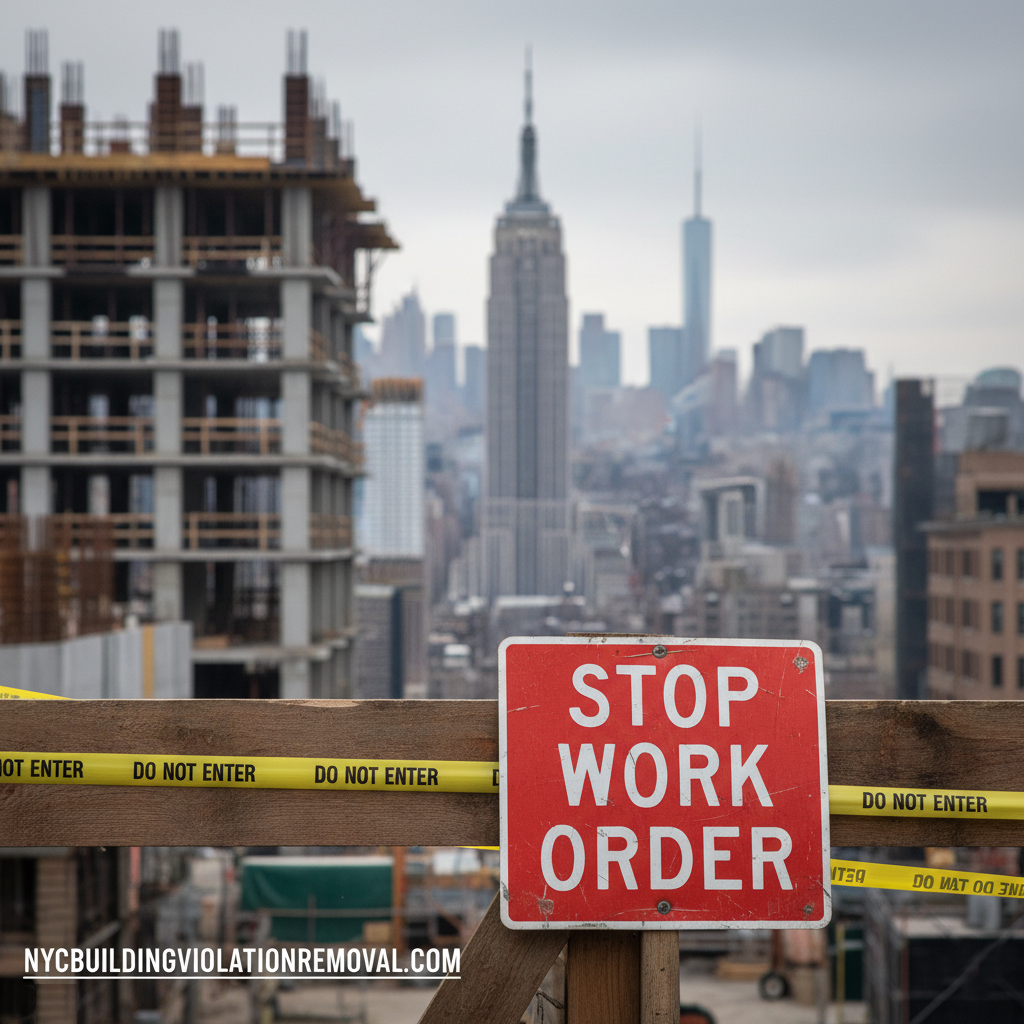
What a Stop Work Order Means and How to Handle It
Introduction
If you’ve received a Stop Work Order from the New York City Department of Buildings (DOB), you’re not alone — and you’re not powerless. A stop work order is serious, but with the right approach and professional help, you can work through it. In this article we’ll explain what it means, why you might receive one, the risks of ignoring it, and how we at Building Violation Removal & Expediting LLC can help you lift it and get your project back on track.
What is a Stop Work Order?
A stop work order is issued when the DOB determines that construction, alteration, repair or other work being performed is unsafe, unpermitted, non‑compliant with approved plans, or otherwise poses a hazard. The order requires that all work stop immediately until the issues identified are resolved. This is different from other violations or permit issues — the project must stop.
Why Might You Receive One?
- Work being done without the proper permit or approvals.
- Work not matching the approved construction documents or plans.
- Unsafe conditions (e.g., structural issues, scaffolding problems, fire/safety hazards).
- Failure to follow prior violation remedy instructions.
- Lack of required inspections or failing required inspections.
When the DOB issues a stop work order, it will include — or will soon include — case information about what triggered it, what must be fixed, and any conditions for lifting the order.
The Risks of Ignoring a Stop Work Order
Ignoring a stop work order is risky. Potential consequences include:
- Fines and escalating penalties from the DOB.
- A halt to the ability to obtain final approvals or a certificate of occupancy.
- Possibility of further enforcement action — including vacate orders, structural filings, or court appearances.
- Delays in your project timeline and increased costs.
- Legal exposure: insurance might not cover work done in violation of a stop work order.
In short: the sooner you act, the better.
How to Respond & Lift the Stop Work Order
Here’s a step‑by‑step overview of how to move forward:
- Review the order carefully – Identify the exact reason for the stop work order and what the DOB is requiring: plan corrections, permits, inspections, safety remediation, etc.
- Stop all work – Until the order is lifted you must stop work to avoid further violations or penalty.
- Engage professionals – This may include architects, engineers, contractors, permit expeditors, or legal representation.
- Correct the violations or unsafe conditions – Address the items cited. This might mean submitting corrected drawings, applying for proper permits, performing required inspections, or abating unsafe conditions.
- Submit required documentation and inspections – Once you’ve done the corrective work you’ll need to file with the DOB (or other relevant agency) and schedule any inspections required.
- Apply for removal / clearance of the stop work order – After compliance you can request that the stop work order be rescinded or lifted, and your permit/project allowed to resume.
- Resume work once cleared – Only after official clearance should work resume — keep documentation of the clearance for your records.
How We Can Help
At Building Violation Removal & Expediting LLC, we specialize in helping property‑owners, contractors and developers through the complex DOB enforcement process. Here's what we do:
- Evaluation: We review your stop work order, determine exactly what is required, and map out a remediation plan.
- Permit & Drawing Corrections: If you need corrected drawings or permits we liaise with architects/engineers and submit accordingly.
- Expediting & Liaison: We act as your liaison with the DOB, schedule inspections, submit paperwork, and help track progress.
- Violation Removal / Clearance: Once compliance is achieved, we help secure the official clearance so you can resume work without risking further penalties.
- Representation: If your matter involves hearings, violations, or legal enforcement, we can coordinate representation or refer you to trusted legal counsel.
With our help you avoid unnecessary delays, added fines, or disruption of your project.
Quick Tips to Avoid a Stop Work Order in the First Place
- Always obtain the correct permits before starting work.
- Make sure your drawings/plans match the work being done and are DOB‑approved.
- Use licensed contractors and keep records of inspections.
- Stay on top of any open violations — unresolved issues often trigger more serious enforcement.
- Keep safety standards high on‑site — many stop work orders are due to unsafe work conditions or scaffolding/structure issues.
Conclusion
A stop work order doesn’t have to mean the end of your project — but it does mean you must act promptly and correctly. If you’re facing a stop work order in New York City, don’t wait. Reach out to us at Building Violation Removal & Expediting LLC, give us a call at 347‑828‑1917 or email nycviolationremovalinc@gmail.com, and let us help you get your project moving again, legally and efficiently.
Email Us Now